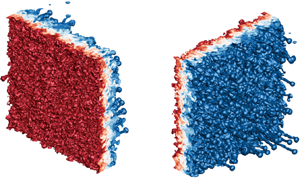Article contents
Mixing and inter-scale energy transfer in Richtmyer–Meshkov turbulence
Published online by Cambridge University Press: 08 April 2024
Abstract

This work investigates the compressible turbulence induced by Richtmyer–Meshkov (RM) instability using high-resolution Navier–Stokes simulations. Special attention is paid to the characteristics of RM turbulence including the mixing width growth, the turbulent kinetic energy (TKE) decay, the mixing degree, inhomogeneity and anisotropy. Three distinct initial perturbation spectra are designed at the interface to reveal the initial condition imprint on the RM turbulence. Results show that cases with initial large-scale perturbations present a stronger imprint on statistical characteristics and also a quicker growth of mixing width, whereas cases with small-scale perturbations present a faster TKE decay, greater mixing level, higher isotropy and homogeneity. A thorough analysis on the inter-scale energy transfer in RM turbulence is also presented with the coarse-graining approach that exposes the two subfilter-scale (SFS) energy fluxes (i.e. deformation work and baropycnal work). A strong correlation between the nonlinear model of baropycnal work (Fluids, 4(2), 2019) and the simulation results is confirmed for the first time, demonstrating its potential in modelling the RM turbulence. Two primary mechanisms of baropycnal work (the straining and baroclinic generation processes) are explored with this nonlinear model. The evolutions of two SFS energy fluxes exhibit distinct behaviours at various filter scales, in different flow regions and under various flow motions (strain and rotation). It is found that all three cases share the common inter-scale energy transfer dynamics, which is important for modelling the RM turbulence.
Information
- Type
- JFM Papers
- Information
- Copyright
- © The Author(s), 2024. Published by Cambridge University Press
References
- 7
- Cited by


